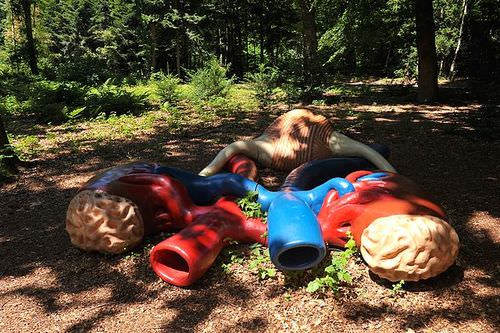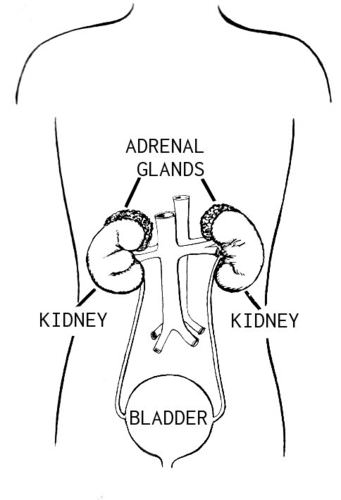18.3 泌尿系统介绍
章节大纲
-
Sculpture Garden
::雕塑花园You can see this interesting outdoor art installation at The Hague in the Netherlands. It’s a colorful piece with an unusual subject — the wrinkled structures on each side of the sculpture represent the , and the striped structure in the distance represents the urinary bladder . The red and blue tubes are , and the tan tubes are ureters . In short, the installation is a three-dimensional depiction of the human urinary system. Only one urinary system organ is not visible in the photo. Do you know what it is?
::你可以看到荷兰海牙这个有趣的户外艺术设施。这是一个多彩的作品,有不同寻常的题材 — — 雕塑两侧的皱纹结构代表着这个东西,远处的条纹结构代表着尿囊。红色和蓝色的管子是,而棕色管是尿管。简言之,安装是对人类尿道系统的三维描述。照片中只可以看到一个尿道器官。你知道它是什么吗?What is the Urinary System?
::什么是尿尿系统?The actual human urinary system , also known as the renal system, is shown in the drawing . The system consists of the kidneys, ureters, bladder , and urethra , which is the only structure not visible in the sculpture above. The main function of the urinary system is to eliminate the waste products of metabolism from the body by forming and excreting urine . Typically, between one and two liters of urine are produced every day in a healthy individual.
::实际的人类尿道系统,又称肾系统,在绘图中显示。这个系统由肾脏、尿管、膀胱和尿道组成,这是上述雕塑中唯一看不到的结构。尿道系统的主要功能是通过形成和排出尿,消除人体新陈代谢的废品。典型的情况是,健康的个人每天产生一到两升尿。The components of the urinary system include the two kidneys, two ureters, bladder, and urethra. The urinary system is the same in males and females, except the urethra is longer in males.
::尿道系统的组成部分包括两个肾脏、两个尿管、膀胱和尿道,男性和女性的尿道系统相同,但男性的尿道系统较长。Organs of the Urinary System
::内脏系统器官The urinary system is all about urine. It includes organs that form urine, and also those that transport, store, or excrete urine.
::尿道系统与尿液有关,包括形成尿液的器官,以及运输、储存或排泄尿的器官。Kidneys
::肾Urine is formed by the kidneys, which filter many substances out of the , allow the blood to reabsorb needed materials, and use the remaining materials to form urine. The normally has two paired kidneys, although it is possible to get by quite well with just one. As you can see in the figure , each kidney is well supplied with blood vessels by a major artery and vein . Blood to be filtered enters the kidney through the renal artery , and the filtered blood leaves the kidney through the renal vein. The kidney itself is wrapped in a fibrous capsule , and consists of a thin outer layer called the cortex, and a thicker inner layer called the medulla.
::尿液由肾组成,肾脏从体内过滤许多物质,让血液重新吸附所需材料,并使用剩余材料形成尿液。通常肾脏有两个配对的肾脏,但只有一个可以很好地通过。从图中可以看出,每个肾脏都由主要的动脉和血管提供大量血管。血液通过肾动脉过滤进入肾脏,经过滤的血液通过肾脏静脉将肾脏从肾脏中分离出来。肾脏本身被包在一个纤维胶囊中,由一层薄薄的外层组成,叫做皮层,一个更厚的内层叫做脑膜。The structure of the kidney is specialized to filter blood and form and collect urine.
::肾脏的结构专门用来过滤血液、形成和收集尿液。Blood is filtered and urine is formed by tiny functional units called nephrons . Each kidney contains at least a million nephrons, and each nephron spans the cortex and medulla layers of the kidney. After urine forms in the nephrons, it flows through a system of converging collecting ducts. The collecting ducts join together to form minor calyces (or chambers) that join together to form major calyces (see the diagram above). Ultimately, the major calyces join the renal pelvis , which is the funnel-like end of the ureter where it enters the kidney.
::血液是过滤的,尿液是由微小的功能单位组成,称为肾,每个肾至少含有100万个肾,每个肾横跨肾的皮层和中子层。在肾脏中出现尿液后,通过凝结收集管道的系统流动。收集的管道合在一起形成细的阴道(或室),形成主要的阴道(见以上图)。最终,主要的阴道加入肾盆,这是进入肾脏的尿道的漏斗之端。Ureters, Bladder, Urethra
::Ureters、Bladder、UrethraAfter urine forms in the kidneys, it is transported through the ureters (one per kidney) to the sac-like bladder, which stores the urine until urination . During urination, the urine is released from the bladder and transported by the urethra to be excreted outside the body through the external urethral opening.
::在肾脏出现尿液后,尿液通过尿管(每个肾脏一个)运到囊状膀胱,将尿液储存到尿液中,在尿液中,尿液从膀胱中释放出来,由尿道通过外部尿道开口排出体外。Functions of the Urinary System
::内尿系统功能Waste products removed from the body with the formation and elimination of urine include many water-soluble metabolic products. The main waste products are urea — a by-product of catabolism — and uric acid, a by-product of catabolism. Excess and mineral ions are also eliminated in urine.
::随着尿液的形成和消除而从身体中去除的废物产品包括许多可溶水的新陈代谢产品,主要废物产品是尿素——催化的副产品——和尿酸——催化的副产品,在尿液中还消除了过多和矿物离子。Besides the elimination of waste products such as these, the urinary system has several other vital functions. These include:
::除了消除此类废物外,尿道系统还有其他几项重要功能,包括:-
Maintaining
of mineral ions in extracellular fluid
: These ions are either excreted in urine or returned to the blood as needed to maintain the proper
balance
.
::维持外细胞液中的矿物离子:这些离子要么排出在尿液中,要么按保持适当平衡的需要还给血液。 -
Regulating acid-base balance in the body
:
W
hen pH is too low (blood is too acidic), for example, the kidneys excrete less bicarbonate (which is basic) in urine. When pH is too high (blood is too basic), the opposite occurs, and more bicarbonate is excreted in urine.
::调节身体的酸基平衡:当pH值太低(血液太酸)时,例如肾脏会排出较少的尿液中的碳酸酯(这是最基本的 ) 。 当pH值太高(血液太基本 ) 时, 情况正好相反, 更多的碳酸盐会排出尿液中。 -
Controlling the volume of extracellular fluids, including the blood, which helps maintain
:
The kidneys control fluid volume and blood pressure by excreting more or less salt and water in urine.
::肾脏通过在尿液中或多或少地排出盐和水来控制液体体积和血压。
Control of the Urinary System
::肠系统控制The formation of urine must be closely regulated to maintain body-wide homeostasis. Several endocrine help control this function of the urinary system, including antidiuretic hormone , parathyroid hormone, and aldosterone.
::一些内分泌有助于控制尿道系统的这一功能,包括抗二尿素激素、除虫菊激素和 aldosterone。-
Antidiuretic hormone
, also called vasopressin, is secreted by the
posterior
pituitary gland
. One of its main roles is conserving body water. It is released when the body is dehydrated, and it causes the kidneys to excrete less water in urine.
::甲状腺的后脑下垂体是隐秘的,其主要作用之一是保护身体水,在身体脱水后释放,导致肾脏排出较少的尿液。 -
Parathyroid hormone
is secreted by the
parathyroid glands
. It works to regulate the balance of mineral ions in the body
via
its effects on several organs, including the kidneys. Parathyroid hormone stimulates the kidneys to excrete less
calcium
and more phosphorus in urine.
::对包括肾脏在内的若干器官产生影响,以此调节体内矿物离子的平衡,对肾脏产生影响,对肾脏造成静态激素刺激肾脏在尿液中排出较少的钙和更多的磷。 -
Aldosterone
is secreted by the cortex of the
adrenal glands
, which rest atop the kidneys, as shown in the figure
. Through its effect on the kidneys, it plays a central role in regulating blood pressure. It causes the kidneys to excrete less sodium and water in urine.
::肾上腺的皮层隐藏了阿尔多酮,肾上腺的皮层在肾上休息,如图所示。它通过其对肾脏的影响,在调节血压方面发挥了中心作用,导致肾脏在尿液中排出较少的钠和水。
The adrenal glands are located on top of the kidneys. They secrete aldosterone into the bloodstream, which carries it to the kidneys.
::肾上腺脏位于肾脏上方,它们将阿多斯特酮分泌到血液中,然后通过血液将其注入肾脏。Once urine forms, it is excreted from the body in the process of urination. This process is controlled by both the autonomic and the somatic nervous systems. As the bladder fills with urine, it causes the autonomic nervous system to signal a muscle in the bladder wall to contract, and the sphincter between the bladder and urethra to relax and open. This forces urine out of the bladder and through the urethra. Another sphincter at the distal end of the urethra is under voluntary control. When it relaxes under the influence of the somatic nervous system , it allows urine to leave the body through the external urethral opening.
::一旦尿液形式从身体中排出,便会在尿液过程中排出;这一过程由自主和体能神经系统控制;由于膀胱充斥着尿液,导致自体神经系统在膀胱墙上发出肌肉信号,使肌肉萎缩,使膀胱和尿道之间的螺旋体松开,使尿液从膀胱和尿道中排出,通过尿道排出,尿液在尿道的阴部的另一端受到自愿控制;当尿液在体能神经系统影响下放松时,允许尿液通过外部尿道开口离开身体。Summary
::摘要-
The urinary system consists of the kidneys, ureters, bladder, and urethra. The main function of the urinary system is to eliminate the waste products of metabolism from the body by forming and excreting urine.
::尿道系统由肾脏、尿管、膀胱和尿道组成,其主要功能是通过形成和排出尿液,从身体中消除新陈代谢的废物。 -
Urine is formed by the kidneys, which filter many substances out of blood, allow the blood to reabsorb needed materials, and use the remaining materials to form urine. Blood to be filtered enters the kidney through the renal artery, and filtered blood leaves the kidney through the renal vein.
::尿液由肾脏组成,肾脏将许多物质从血液中过滤出来,允许血液再吸附所需材料,并利用剩余材料形成尿。 血液过滤通过肾动脉进入肾脏,经过滤的血液通过肾静脉将肾离开。 -
Within each kidney, blood is filtered and urine is formed by tiny structural and functional units called nephrons, of which there are at least a million in each kidney.
::每个肾脏内都有血液过滤器,尿液由微小的结构和功能单位组成,称为肾脏,其中每个肾脏至少有100万个。 -
After urine forms in the kidneys, it is transported through the ureters to the bladder. The bladder stores the urine until urination, when urine is transported by the urethra to be excreted outside the body.
::在肾脏出现尿液后,尿液通过尿管运到膀胱,膀胱将尿液储存到尿液中,直到尿液通过尿道运出尿液排出体外。 -
Besides the elimination of waste products (such as urea, uric acid, excess water, and mineral ions), the urinary system has other vital functions. These include maintaining homeostasis of mineral ions in extracellular fluid, regulating acid-base balance in the blood, regulating the volume of extracellular fluids, and controlling blood pressure.
::除了消除废物(如尿素、尿素酸、过量水和矿物离子)之外,尿道系统还有其他重要功能,包括保持外细胞液中矿物离子的均匀性,调节血液中的酸基平衡,调节外细胞液的数量,控制血压。 -
The formation of urine must be closely regulated to maintain body-wide homeostasis. Several endocrine hormones help control this function of the urinary system, including antidiuretic hormone from the
posterior pituitary gland
, parathyroid hormone from the parathyroid glands, and aldosterone from the adrenal glands.
::一些内分泌激素有助于控制尿道系统的这一功能,包括后脑垂体腺的抗亚尿激素、对甲状腺的对甲状腺激素和肾上腺的甲状腺的甲状腺激素。 -
The process of urination is controlled by both the autonomic and the somatic nervous systems. The autonomic system causes the bladder to empty, but conscious relaxation of the sphincter at the distal end of the urethra allows urine to leave the body.
::排尿过程由自主和体能神经系统控制。 自动神经系统导致膀胱空空,但尿道阴部侧端的脊椎自觉放松允许尿液离开身体。
Review
::回顾1. What organs make up the urinary system?
::1. 尿道系统由哪些器官组成?2. State the main function of the urinary system.
::2. 说明尿道系统的主要功能。3. What is the primary function of the kidneys?
::3. 肾的主要功能是什么?4. Describe how blood enters and leaves the kidneys.
::4. 描述血液如何进入和离开肾脏。5. What are nephrons?
::5. 什么是甲状腺?6. What happens to urine after it forms in the kidneys?
::6. 尿进入肾脏后会怎样?7. Other than the elimination of waste products, identify functions of the urinary system.
::7. 除了消除废品之外,还要确定尿道系统的职能。8. How is the formation of urine regulated?
::8. 如何管理尿液的形成?9. Explain how the process of urination is controlled.
::9. 说明如何控制尿道过程。10. What urine-related function do the adrenal glands carry out?
::10. 肾上腺与尿液有关的功能是什么?a. They form urine and transport it to the kidneys.
::a. 形成尿液并将尿液运至肾脏。b. They excrete concentrated urine into the ureters.
::b. 将集中的尿液排入尿管。c. They secrete a hormone that affects the composition of urine.
::c. 分泌影响尿液成分的荷尔蒙。d. They store urine when water and salts need to be retained by the body.
:d) 当身体需要保留水和盐类时,它们会储存尿液。
11. Explain why it is important to have voluntary control over the sphincter at the end of the urethra.
::11. 解释为什么在尿道末端自愿控制螺旋杆是重要的。12. I n terms of how they affect the kidneys, c ompare aldosterone to antidiuretic hormone.
::12. 关于它们如何影响肾脏,将aldosterone与抗亚尿激素作比较。13. If your body needed to retain more calcium, which of the hormones described in this concept is most likely to increase? Explain your reasoning.
::13. 如果你的身体需要保留更多的钙,这个概念中描述的哪些荷尔蒙最有可能增加?解释你的推理。14. True or False: Urine is composed of water, urea, and minerals only.
::14. 真实或虚假:尿液由水、尿素和矿物组成。15. True or False: The renal artery contains blood that was filtered by the kidney.
::15. 真实或假:肾动脉含有经肾脏过滤的血液。Explore More
::探索更多Did you ever hear of m aple-syrup u rine d isease? Learn more about it here:
::你听说过麻黄碱尿病吗?Many employers require a urine-based drug test upon hire, but are they really that accurate? Watch this video to learn more.
::许多雇主雇用时需要尿质药物测试, -
Maintaining
of mineral ions in extracellular fluid
: These ions are either excreted in urine or returned to the blood as needed to maintain the proper
balance
.



